Craving Corn and the Cob
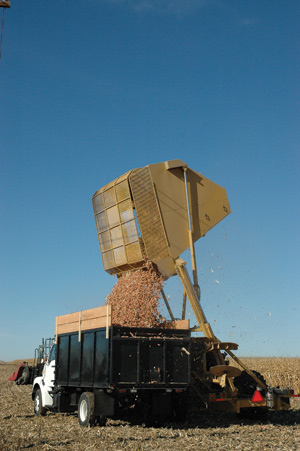


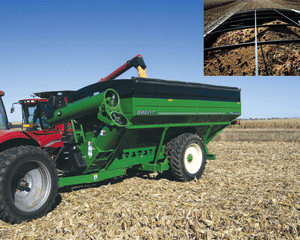
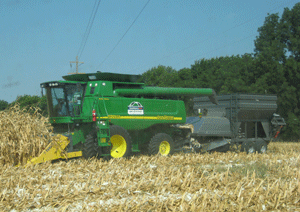
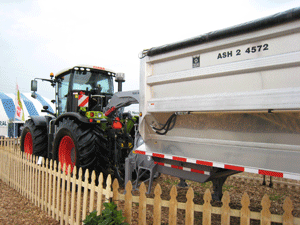
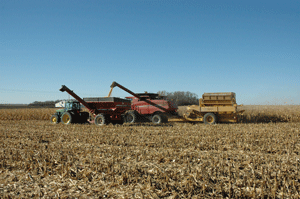
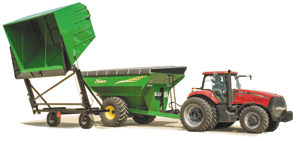











January 1, 1970
BY Ryan C. Christiansen
It might not look like a revolution: men and women in Carhartt jackets and feed caps standing in a corn field watching a combine harvest grain. Adjusting the car radio, yawning or blinking, the casual traveler passing by might miss the rebellion. The American farmer, however, might pause-and smile. He sees that the harvest is for more than just grain.
Cobs, too, are being collected and hauled away from the field. Under the banner of energy independence, ethanol producers-along with agricultural equipment manufacturers of every color-are working together to generate more fuel from the field.
Cob Harvest Demand
To spur the commercial production of cellulosic ethanol, the 2008 Farm Bill includes a $1.01 per gallon tax credit through 2012. Sioux Falls, S.D.-based ethanol producer Poet LLC has selected corn cobs as its cellulosic ethanol feedstock. According to Doug Berven, director of corporate affairs for Poet, cobs are an excellent feedstock because they are consistent in quality, they can be collected during the main corn grain harvest, they have good bulk density, and farmers are more willing to collect cobs than the remaining corn stover, mainly because the stalks, leaves and husks provide valuable nutrients when left to decay in the soil. Berven says cobs are a logical feedstock for producing cellulosic ethanol, and 5 billion gallons of ethanol could potentially be produced each year from cobs alone.
With $80 million from the U.S. DOE, Poet is perfecting cob-to-ethanol conversion at the Poet Research Center in Scotland, S.D., and is converting a 50 MMgy corn grain-to-ethanol plant in Emmetsburg, Iowa, into an integrated corn-grain-to-ethanol and cob-to-ethanol biorefinery to produce 125 MMgy of ethanol-25 MMgy from cobs and also from corn fiber derived through grain fractionation. The process will allow Poet to produce 27 percent more ethanol from an acre of corn. Construction in Emmetsburg is expected to begin this year and Poet plans to produce cellulosic ethanol commercially by 2011. The plant will require 275,000 acres of cobs annually.
Another ethanol producer wants to use corncobs to help fuel its corn grain ethanol production process. Chippewa Valley Ethanol Co. LLLP of Benson, Minn., will convert cobs in a gasifier to synthesis gas to replace 75 percent or more of the natural gas needs at its 45 MMgy plant. According to Gene Fynboh, the harvest coordinator and a board member for the Chippewa Valley Agrafuels Co-op, cobs are desirable for gasification because a ton of cobs produces a similar amount of British thermal units as a ton of coal, with little ash.
CVEC isn't the only company on the southern edge of the Central Lakes area of Minnesota looking at cobs for energy. The University of Minnesota, Morris wants cobs for its gasifier and Willmar Municipal Utilities in the city of Willmar, Minn., plans to test burn cobs with coal at its 16 megawatt (MW) coal-fired power plant this winter. According to Bruce Gomm, general manager for the utility, because Minnesota has mandated all utilities produce 25 percent of their energy through renewable resources by 2025, the goal is to burn 20 percent to 30 percent cobs. "Our research indicates there is quite a large quantity of cobs available [in the area] … plenty to meet everybody's needs," Gomm says. Jon Folkedahl, a consultant for the utility, says 150,000 acres of corn were planted in Minnesota's Kandiyohi County last year. "The farmer will feel more comfortable investing in cob harvesting equipment if he knows that there is more than one market available in the area," Folkedahl says. "Cobs are the hottest thing going in terms of renewable fuels."
Cob Harvest Evangelism
To evangelize the economic benefits of harvesting cobs with grain, Poet and CVEC have demonstrated the prototypes that agricultural equipment manufacturers have developed for harvesting, transporting and storing cobs. Poet held a demonstration on 4,000 acres near Hurley, S.D., in October 2007, and in November 2008 displayed equipment for approximately 750 farmers near Emmetsburg. "What's exciting is that so many equipment companies, and all of the major equipment companies, are working on this," says Jim
Sturdevant, director of Poet's Project Liberty cob-to-ethanol initiative. Poet tested harvesting 10,000 acres of cobs in Texas, Iowa and South Dakota in 2008.
CVEC held three cob harvesting demonstrations in October near Donnelly, Priam and Holloway, Minn., with the goal of harvesting 5,000 acres of cobs from more than a dozen farmers. The company received applications offering more than 25,000 acres for the harvest, Fynboh says.
Numerous growers volunteered for the Willmar utility's 450-ton cob harvest, but in the end logistics, timing and equipment availability prompted them to work with a single grower, Folkedahl says.
Sturdevant says interest among farmers is growing. "This is an opportunity for farmers to get an additional revenue stream without requiring them to change their planting practices," he says.
The companies have yet to determine how much to pay for cobs. Poet has suggested that the cobs are worth between $30 and $60 per ton. The most recent Farm Bill includes the Biomass Crop Assistance Program, which allows for farmers to be reimbursed up to $45 per ton for the collection, harvest, storage and transportation of feedstock to a cellulosic ethanol biorefinery.
Cob Harvest Equipment
Corn grain is typically harvested using a combine that strips the ears from the stalks and then separates the grain from the ears, depositing cobs and the rest of the stover back on to the field. Agricultural equipment manufacturers have come up with multiple ways for harvesting cobs during the same field pass, which prevents farmers from having to pick up cobs from the ground, and keeps dirt from being collected with the cobs. The manufacturers know the first criteria farmers have for cob harvesting is that the equipment should not slow down the grain harvest, because the window for harvesting corn can be small due to weather constraints.
Manufacturers have employed three basic harvesting techniques: using a modified combine to harvest a mixture of cobs and grain together (dubbed corn-cob mix or CCM), using a modified combine to harvest and also separate cobs and grain, or using a cob "caddy" towed behind the combine to harvest cobs from stover ejected by the grain combine.
Corn-Cob Mix Harvest
The CCM harvest technique uses a modified combine to harvest a mixture of whole or broken cobs and clean grain into the same bin. The cobs and grain are then separated using a second machine on the side of the field. The farmer doesn't have to change harvesting practices while operating the combine, but would have to consider using a modified grain cart that can better handle the emptying of the cob-grain mix. Additional equipment is required to separate the cobs from grain after harvest.
The manufacturers involved in this technique include CNH America LLC with its Case IH combines, Claas of America Inc. with its Lexion combines and Deere & Co. with its John Deere combines.
"It's relatively minor modifications," says Sam Acker, director of marketing for Case IH harvesting equipment at CNH. "In a couple of hours of changing some parts out, a guy can go from just harvesting the grain to harvesting a corn-cob mix."
"Within the next couple of years-once we get a good handle on what type of solutions our customers are looking for-we will have a kit available to convert a combine over to do the corn-cob mix," says Barry Nelson, manager of media and channel relations for Deere.
A conversion kit is already available for the Claas Lexion combine, according to Bob Armstrong, product marketing manager for Claas. He says the modification is a variation on what is available for harvesting earlage.
To catch and transport the CCM from the combine, Armstrong says Claas has a Xerion multipurpose tractor with a fifth wheel and a 53-foot aluminum trailer that can be transferred to a semi tractor for high-speed road transport to a feedstock purchaser.
Unverferth Manufacturing Co. Inc. has developed the dual-auger Brent Avalanche 1194CCM grain cart, which has been designed specifically for emptying the CCM. "Being dense and slippery, [corn grain] flows very well but, once you get the less-dense corncobs and some of the fodder from the corn plant itself in there, its flow ability is reduced, and so we have made modifications to the inside of the cart," says Jerry Ecklund, advertising manager for Unverferth.
To separate cobs from grain, Wildcat Manufacturing has a modification for its 626 Cougar trommel screen system, according to Shannon Wezensky, design engineer for Wildcat.
On-Combine Cob Separation
The on-combine cob separation technique uses a modified combine to harvest cobs and grain into separate bins. The manufacturer involved in this technique is primarily Ceres Agriculture Consultants. The Ceres Ag Residue Recovery System sorts stover at the back of the combine and then collects cobs in a hopper on top of the combine.
Tow-Behind Cob Harvest
The tow-behind cob harvest technique uses a cob caddy hitched to the back of the combine. The machine catches the stover from the combine to collect the cobs. A hitch must be installed on the combine, meaning the combine will work harder to pull the weight of the equipment and the cobs. "That's obviously a concern," Ackers says. "The combines up to this point-I don't care which [manufacturer]-their chassis haven't been designed for pulling a big, heavy cart behind them. What [Case IH] is looking at with our own (tow-behind) design, as well, is what do we need to do with the rear axle and rear frame of the combine to ensure that it's all going to hold together when we do this?"
Because cobs are less dense than grain, the cob caddy needs to be emptied more often than the grain cart. The manufacturers involved in this technique include CNH America LLC, Vermeer Corp. and Redekop Manufacturing.
To support collecting grain from the combine and cobs from the caddies during a single harvest pass, Dethmers Manufacturing Co. (Demco) has developed the dual-cart 2-SKU Cob Cart, according to Ken Streff, vice president of sales and marketing for Demco. Streff says the front cart collects grain. The rear cart is connected using a swing hitch so that it can be positioned beside the cob caddy for cob collection.
Obtaining Harvesting Equipment
Most cob harvesting equipment is not yet available for purchase and most manufacturers haven't determined pricing, which makes it difficult for farmers to weigh the cost of harvesting cobs against the value of their cobs-which is also still an unknown.
No matter. Machinery Link, an agricultural equipment leasing company based in Kansas City, Mo., plans to have cob harvesting equipment available for lease as soon as possible, according to Landon Morris, vice president of marketing for Machinery Link. Morris urges farmers to consider leasing. "We lease combines because they are a very expensive and highly specialized asset," he says. "Whichever of the cob units become commercial, they will fall into the same asset class. They are new pieces of equipment that have never existed before, and so we don't know what the residual value of those pieces of equipment will be or what their useful life will be. This is an ideal model for leasing or short-term rentals as opposed to asking a producer to bear the burden of purchasing an asset for cob collection."
Morris says the farmers he has talked to are excited to begin harvesting cobs. "I think they are all hopeful," he says. "Farmers are generally optimistic. Otherwise, they wouldn't be farmers, right?"
Cob Harvest Logistics
Researchers at the U of M, Morris have looked at cob storage and transportation issues and have determined that cobs can be stored in the field temporarily, so long as the piles are removed before spring. This provides growers and feedstock purchasers with a practical, inexpensive storage option. So far, both Poet and CVEC have asked farmers to pile cobs at the edges of their fields and have shouldered the cost of transporting cobs to their facilities. Meanwhile, researchers continue to examine whether broken or whole-cob pieces store best and which is best for transportation.
A Commercial Harvest
The first, small-scale commercial harvest of cobs for Poet and CVEC will be in the fall of 2009. "We will work with farmers and buy cobs, probably through a contract approach," Sturdevant says. "We'll just keep this evolution going so that in 2009, a number of farmers are actually harvesting cobs and then in 2010, there will be more machinery available for lease or purchase and there will be more farmers involved. We will just let it grow from there."
CVEC currently purchases corn from approximately 112,000 acres of land supplied by members of its associated cooperative. "We expect that those same 112,000 acres could provide 75 percent of the energy needs for operating the plant if we use all of the corn cobs," Fynboh says. "It's not an insurmountable task. Twenty-five years ago, you couldn't imagine the pile of corn that we're producing now."
Ryan C. Christiansen is a Biomass Magazine staff writer. Reach him at rchristiansen@bbiinternational.com or (701) 373-8042.
Cobs, too, are being collected and hauled away from the field. Under the banner of energy independence, ethanol producers-along with agricultural equipment manufacturers of every color-are working together to generate more fuel from the field.
Cob Harvest Demand
To spur the commercial production of cellulosic ethanol, the 2008 Farm Bill includes a $1.01 per gallon tax credit through 2012. Sioux Falls, S.D.-based ethanol producer Poet LLC has selected corn cobs as its cellulosic ethanol feedstock. According to Doug Berven, director of corporate affairs for Poet, cobs are an excellent feedstock because they are consistent in quality, they can be collected during the main corn grain harvest, they have good bulk density, and farmers are more willing to collect cobs than the remaining corn stover, mainly because the stalks, leaves and husks provide valuable nutrients when left to decay in the soil. Berven says cobs are a logical feedstock for producing cellulosic ethanol, and 5 billion gallons of ethanol could potentially be produced each year from cobs alone.
With $80 million from the U.S. DOE, Poet is perfecting cob-to-ethanol conversion at the Poet Research Center in Scotland, S.D., and is converting a 50 MMgy corn grain-to-ethanol plant in Emmetsburg, Iowa, into an integrated corn-grain-to-ethanol and cob-to-ethanol biorefinery to produce 125 MMgy of ethanol-25 MMgy from cobs and also from corn fiber derived through grain fractionation. The process will allow Poet to produce 27 percent more ethanol from an acre of corn. Construction in Emmetsburg is expected to begin this year and Poet plans to produce cellulosic ethanol commercially by 2011. The plant will require 275,000 acres of cobs annually.
Another ethanol producer wants to use corncobs to help fuel its corn grain ethanol production process. Chippewa Valley Ethanol Co. LLLP of Benson, Minn., will convert cobs in a gasifier to synthesis gas to replace 75 percent or more of the natural gas needs at its 45 MMgy plant. According to Gene Fynboh, the harvest coordinator and a board member for the Chippewa Valley Agrafuels Co-op, cobs are desirable for gasification because a ton of cobs produces a similar amount of British thermal units as a ton of coal, with little ash.
CVEC isn't the only company on the southern edge of the Central Lakes area of Minnesota looking at cobs for energy. The University of Minnesota, Morris wants cobs for its gasifier and Willmar Municipal Utilities in the city of Willmar, Minn., plans to test burn cobs with coal at its 16 megawatt (MW) coal-fired power plant this winter. According to Bruce Gomm, general manager for the utility, because Minnesota has mandated all utilities produce 25 percent of their energy through renewable resources by 2025, the goal is to burn 20 percent to 30 percent cobs. "Our research indicates there is quite a large quantity of cobs available [in the area] … plenty to meet everybody's needs," Gomm says. Jon Folkedahl, a consultant for the utility, says 150,000 acres of corn were planted in Minnesota's Kandiyohi County last year. "The farmer will feel more comfortable investing in cob harvesting equipment if he knows that there is more than one market available in the area," Folkedahl says. "Cobs are the hottest thing going in terms of renewable fuels."
Cob Harvest Evangelism
To evangelize the economic benefits of harvesting cobs with grain, Poet and CVEC have demonstrated the prototypes that agricultural equipment manufacturers have developed for harvesting, transporting and storing cobs. Poet held a demonstration on 4,000 acres near Hurley, S.D., in October 2007, and in November 2008 displayed equipment for approximately 750 farmers near Emmetsburg. "What's exciting is that so many equipment companies, and all of the major equipment companies, are working on this," says Jim
Sturdevant, director of Poet's Project Liberty cob-to-ethanol initiative. Poet tested harvesting 10,000 acres of cobs in Texas, Iowa and South Dakota in 2008.
CVEC held three cob harvesting demonstrations in October near Donnelly, Priam and Holloway, Minn., with the goal of harvesting 5,000 acres of cobs from more than a dozen farmers. The company received applications offering more than 25,000 acres for the harvest, Fynboh says.
Numerous growers volunteered for the Willmar utility's 450-ton cob harvest, but in the end logistics, timing and equipment availability prompted them to work with a single grower, Folkedahl says.
Sturdevant says interest among farmers is growing. "This is an opportunity for farmers to get an additional revenue stream without requiring them to change their planting practices," he says.
The companies have yet to determine how much to pay for cobs. Poet has suggested that the cobs are worth between $30 and $60 per ton. The most recent Farm Bill includes the Biomass Crop Assistance Program, which allows for farmers to be reimbursed up to $45 per ton for the collection, harvest, storage and transportation of feedstock to a cellulosic ethanol biorefinery.
Cob Harvest Equipment
Corn grain is typically harvested using a combine that strips the ears from the stalks and then separates the grain from the ears, depositing cobs and the rest of the stover back on to the field. Agricultural equipment manufacturers have come up with multiple ways for harvesting cobs during the same field pass, which prevents farmers from having to pick up cobs from the ground, and keeps dirt from being collected with the cobs. The manufacturers know the first criteria farmers have for cob harvesting is that the equipment should not slow down the grain harvest, because the window for harvesting corn can be small due to weather constraints.
Manufacturers have employed three basic harvesting techniques: using a modified combine to harvest a mixture of cobs and grain together (dubbed corn-cob mix or CCM), using a modified combine to harvest and also separate cobs and grain, or using a cob "caddy" towed behind the combine to harvest cobs from stover ejected by the grain combine.
Corn-Cob Mix Harvest
The CCM harvest technique uses a modified combine to harvest a mixture of whole or broken cobs and clean grain into the same bin. The cobs and grain are then separated using a second machine on the side of the field. The farmer doesn't have to change harvesting practices while operating the combine, but would have to consider using a modified grain cart that can better handle the emptying of the cob-grain mix. Additional equipment is required to separate the cobs from grain after harvest.
The manufacturers involved in this technique include CNH America LLC with its Case IH combines, Claas of America Inc. with its Lexion combines and Deere & Co. with its John Deere combines.
"It's relatively minor modifications," says Sam Acker, director of marketing for Case IH harvesting equipment at CNH. "In a couple of hours of changing some parts out, a guy can go from just harvesting the grain to harvesting a corn-cob mix."
"Within the next couple of years-once we get a good handle on what type of solutions our customers are looking for-we will have a kit available to convert a combine over to do the corn-cob mix," says Barry Nelson, manager of media and channel relations for Deere.
A conversion kit is already available for the Claas Lexion combine, according to Bob Armstrong, product marketing manager for Claas. He says the modification is a variation on what is available for harvesting earlage.
To catch and transport the CCM from the combine, Armstrong says Claas has a Xerion multipurpose tractor with a fifth wheel and a 53-foot aluminum trailer that can be transferred to a semi tractor for high-speed road transport to a feedstock purchaser.
Unverferth Manufacturing Co. Inc. has developed the dual-auger Brent Avalanche 1194CCM grain cart, which has been designed specifically for emptying the CCM. "Being dense and slippery, [corn grain] flows very well but, once you get the less-dense corncobs and some of the fodder from the corn plant itself in there, its flow ability is reduced, and so we have made modifications to the inside of the cart," says Jerry Ecklund, advertising manager for Unverferth.
To separate cobs from grain, Wildcat Manufacturing has a modification for its 626 Cougar trommel screen system, according to Shannon Wezensky, design engineer for Wildcat.
On-Combine Cob Separation
The on-combine cob separation technique uses a modified combine to harvest cobs and grain into separate bins. The manufacturer involved in this technique is primarily Ceres Agriculture Consultants. The Ceres Ag Residue Recovery System sorts stover at the back of the combine and then collects cobs in a hopper on top of the combine.
Tow-Behind Cob Harvest
The tow-behind cob harvest technique uses a cob caddy hitched to the back of the combine. The machine catches the stover from the combine to collect the cobs. A hitch must be installed on the combine, meaning the combine will work harder to pull the weight of the equipment and the cobs. "That's obviously a concern," Ackers says. "The combines up to this point-I don't care which [manufacturer]-their chassis haven't been designed for pulling a big, heavy cart behind them. What [Case IH] is looking at with our own (tow-behind) design, as well, is what do we need to do with the rear axle and rear frame of the combine to ensure that it's all going to hold together when we do this?"
Because cobs are less dense than grain, the cob caddy needs to be emptied more often than the grain cart. The manufacturers involved in this technique include CNH America LLC, Vermeer Corp. and Redekop Manufacturing.
To support collecting grain from the combine and cobs from the caddies during a single harvest pass, Dethmers Manufacturing Co. (Demco) has developed the dual-cart 2-SKU Cob Cart, according to Ken Streff, vice president of sales and marketing for Demco. Streff says the front cart collects grain. The rear cart is connected using a swing hitch so that it can be positioned beside the cob caddy for cob collection.
Obtaining Harvesting Equipment
Most cob harvesting equipment is not yet available for purchase and most manufacturers haven't determined pricing, which makes it difficult for farmers to weigh the cost of harvesting cobs against the value of their cobs-which is also still an unknown.
No matter. Machinery Link, an agricultural equipment leasing company based in Kansas City, Mo., plans to have cob harvesting equipment available for lease as soon as possible, according to Landon Morris, vice president of marketing for Machinery Link. Morris urges farmers to consider leasing. "We lease combines because they are a very expensive and highly specialized asset," he says. "Whichever of the cob units become commercial, they will fall into the same asset class. They are new pieces of equipment that have never existed before, and so we don't know what the residual value of those pieces of equipment will be or what their useful life will be. This is an ideal model for leasing or short-term rentals as opposed to asking a producer to bear the burden of purchasing an asset for cob collection."
Morris says the farmers he has talked to are excited to begin harvesting cobs. "I think they are all hopeful," he says. "Farmers are generally optimistic. Otherwise, they wouldn't be farmers, right?"
Cob Harvest Logistics
Researchers at the U of M, Morris have looked at cob storage and transportation issues and have determined that cobs can be stored in the field temporarily, so long as the piles are removed before spring. This provides growers and feedstock purchasers with a practical, inexpensive storage option. So far, both Poet and CVEC have asked farmers to pile cobs at the edges of their fields and have shouldered the cost of transporting cobs to their facilities. Meanwhile, researchers continue to examine whether broken or whole-cob pieces store best and which is best for transportation.
A Commercial Harvest
The first, small-scale commercial harvest of cobs for Poet and CVEC will be in the fall of 2009. "We will work with farmers and buy cobs, probably through a contract approach," Sturdevant says. "We'll just keep this evolution going so that in 2009, a number of farmers are actually harvesting cobs and then in 2010, there will be more machinery available for lease or purchase and there will be more farmers involved. We will just let it grow from there."
CVEC currently purchases corn from approximately 112,000 acres of land supplied by members of its associated cooperative. "We expect that those same 112,000 acres could provide 75 percent of the energy needs for operating the plant if we use all of the corn cobs," Fynboh says. "It's not an insurmountable task. Twenty-five years ago, you couldn't imagine the pile of corn that we're producing now."
Ryan C. Christiansen is a Biomass Magazine staff writer. Reach him at rchristiansen@bbiinternational.com or (701) 373-8042.
Advertisement
Advertisement
Upcoming Events





